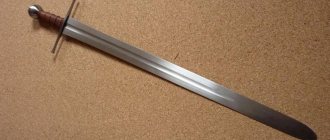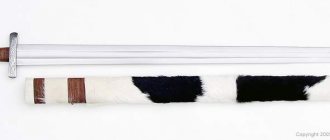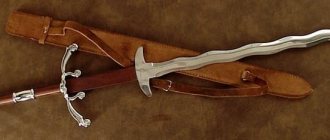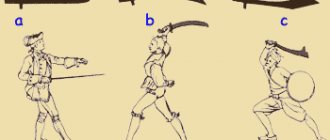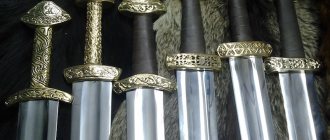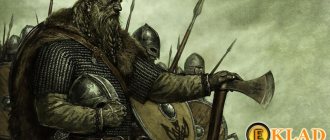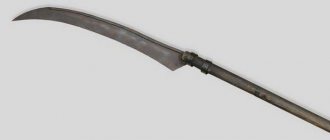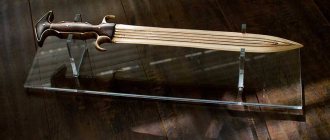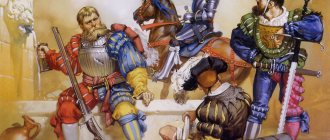“Don't expose me unnecessarily. Do not sheathe me without honor” is the motto on the blade of a sword from Toledo, Spain.
European one-handed sword (device) Guard Pommel Hilt Blade Blade
The European sword consists of two main parts:
The structure of a European one-handed sword
The image shows: a European one-handed sword, Oakeshott type X and a Katzbalger - a short one-handed sword of the Renaissance
1) Handle , which in turn consists of a pommel (apple), handle, guard (cross), shank
2) Blade blade , which in turn consists of a fuller, a blade and a tip.
The history of swords
During coronations and knightings, the sword is used to this day. In heraldry, this is the most common symbol. Mentions of the sword are present in the Bible and the Koran. In modern fantasy films and novels, this item simply cannot be avoided. Despite the romantic component, one should not forget that a sword is, first of all, a bladed weapon.
Birth of the sword, antiquity
It is impossible to say for sure where and when the first sword appeared. Of course, the first products appeared after man learned to process bronze. During excavations in Adygea, on the territory of Russia, the oldest sword was found. The find is 4 thousand years old BC. Currently the item is in the Hermitage.
The metal that allows you to make decent-sized swords is bronze. Of course, its properties are not comparable with modern, and even with Medieval steels. But the first attempts to make swords have already appeared. Bronze cannot be hardened, and the products bent under load.
For this purpose, bronze swords always had impressive stiffening ribs. And good corrosion resistance allows us today to study objects from those times.
Bronze products were made by casting. Therefore, the first swords were given complex and intricate shapes.
How long was the blade?
The length of the blades did not exceed 60 cm, in rare cases it reached 100 cm.
What were large products used for?
Large-sized items were most likely used for ritual purposes.
There are objects from the Ancient world that, in their characteristics, are more likely to be sabers. But here it already depends on modern classifiers. For example, these are the Egyptian khopesh, the Greek makhaira and kopis. There is a very fine line between a saber and a sword, and in some sources they are classified as swords.
Egyptian khopesh, Greek makhaira and kopis.
Already in the 7th century, swords began to be made from iron; this design revolution quickly swept across Europe and the Middle East. No matter how long ago it seemed, but already in those days blacksmiths learned the main secrets of their craft:
- they learned to forge blades in batches;
- welding steel plates onto each other of varying hardness;
- carburization of soft iron billet.
Such production would remain virtually unchanged until the Middle Ages.
Medieval swords
Before the medieval period, the sword took over a thousand years to develop. And we can say that his finest hour came precisely in the periods from the 5th to the 16th centuries. But the collapse of the Roman Empire made its own adjustments to the history of the sword.
Europe plunged into a kind of dark era. The time has come for fragmentation and internecine wars.
Are you interested in the history of the Middle Ages?
Not really.
The number of armies was significantly reduced, and battle tactics were simplified.
The period of the Early Middle Ages is characterized by an almost complete absence of armor. Only rich people could afford chain mail or plate armor.
The battles mostly took place in open areas. Opponents excluded defensive tactics from their arsenal. The beginning of the first millennium was marked by the Great Migration of Peoples. In the territories of the former Roman provinces, new states were created by barbarians. The first European sword is considered to be the German spatha. And his follower was the Merovingian type sword.
It received its name in honor of the royal French Merovingian dynasty. The blade had a rounded tip, a wide flat fuller and a massive pommel. The sword was intended to deliver slashing and cutting blows. At that time, only wealthy people could afford a combat sword.
In turn, the Vikings and Normans regularly attacked northern Europe. Which greatly influenced the type and character of the sword itself. Following their example, swords of the Carolingian type began to appear in Europe in the 8th century. The fierce blond warriors, without knowing it, passed on their experience to the Europeans.
Many Carolingian swords have been found in Scandinavia. The Vikings practiced burying weapons in the same place as the warrior. Thus, many copies of this weapon have survived to this day. Together with the Normans, the Carolingian sword also found its way into Kievan Rus.
In the 11th century, the Carolingian sword was transformed into a knight's sword. This time period is characterized by the development of crafts, the rise of blacksmithing and the growth of cities throughout Europe.
The uniforms of the soldiers also began to improve. And this certainly leads to a change in the shape and characteristics of a one-handed sword:
- total length of the product is about 90 cm;
- light weight for one-handed fencing;
- double-edged blade sharpening;
- the weight of the sword did not exceed 1.2 kg.
The equipment of 13th century fighters included such innovations as plate armor and metal helmets. It becomes impossible to penetrate such a set with a chopping blow. The blades began to taper, a pronounced point appeared for piercing blows. Changes also appeared in the cross section; they became thicker and received stiffening ribs.
Infantry troops began to occupy leading positions in the column. Thanks to improved armor. And for the infantrymen, long swords were invented. One of the varieties of the sword is the bastard sword or bastard sword. Such products had only military use. This blade can be called transitional to two-handed products.
During the late Middle Ages, two-handed fighters entered the arena. These were real giants. The total length of the product sometimes reached two meters, while weighing up to five kilograms. They were worn without a sheath on the shoulder, like a pike or a halberd. The most famous among them are the Zweihander, Claymore, Espadon and Flamberge.
Medieval swords - zweihander, claymore, spandrel and flamberge.
By the 16th-17th centuries, the sword became an increasingly piercing weapon. The grip of the sword in the hand changes, and accordingly the fencing technique changes. The guard of the product becomes more complex for better protection of the fingers and hand. Blades are becoming lighter and more accessible to the population. Swords and rapiers appear and are worn with everyday clothing. And the appearance of firearms puts the sword to rest altogether.
The formation of the sword in antiquity
In early antiquity, bronze steel was actively used in the creation of blades. This alloy, despite its ductility, is distinguished by its strength. The swords of this time are notable for the following: bronze blades were made by casting, which made it possible to create various shapes. In some cases, for greater stability, stiffening ribs were added to the blades. In addition, copper does not corrode, which is why many archaeological finds retain their beautiful appearance to this day.
For example, in the Adygea Republic, during excavations of one of the mounds, a sword was found, which is considered one of the most ancient and dates back to 4 thousand BC. According to ancient customs, during burial, his personal valuables were placed in the mound along with the deceased.
Sword design
The sword is a successor to the axe, but it is much more convenient for piercing, cutting and chopping blows. It is also easier for them to parry enemy attacks. The design of the sword is quite simple: a long blade, a cross and a hilt. The blade takes up most of the weapon. When classifying a product, a significant role is played by the shape of the sword itself and the method of sharpening it:
- sabers include products with a curved blade;
- weapons with one-sided sharpening are classified as broadswords, cutlasses, machetes and others;
- Swords and rapiers are considered separately.
Considering swords in which the cutting part of the blade is a blade ending in a point. But not always, sometimes the tip is rounded. The blade has stiffening ribs and fullers, which make the weapon lighter and stronger. The unsharpened section of the blade after the hilt is called the ricasso or heel.
The hilt of the sword consists of a guard, a hilt and a pommel. The guard carries a triple load:
- prevents the hand from slipping after a blow;
- protects fingers and hand from enemy blows;
- It can also be used to strike an enemy in close combat.
The pommel of the handle prevents the weapon from slipping and serves to balance the product. Also important is the cross-section of the blade; it can be: rhombic, lenticular, tetrahedral, triangular and even hexagonal.
Diagram of sword parts.
The center of gravity of the sword plays a significant role; as a rule, it is located just above the hilt on the blade. But for some specific products, it is deliberately moved closer to the end of the blade. Some specific features of swords should be taken into account:
- the shape of the blade or its profile changed over time, depending on the era and fighting techniques used in that period;
- the cross-section of the blade also depends on the use of a particular sword in battle;
- a forged or chiseled recess along the blade - a dol, there may be more than one, but there may be several of them;
- the mass of the blade is affected by its gradual narrowing towards the tip, which may not exist at all.
Blade
The blade has many interpretations united by a common message. A blade is: 1) the cutting part of a bladed weapon or knife (literary dictionary, Ushakov); 2) the cutting and piercing part of edged weapons (literary dictionary, Ozhegov); 3) strip, generally the steel part of a cold, sharp weapon (except for a bayonet) and a knife (literary dictionary, Dahl).
And yet, what concept should be the key? It would be correct to turn to the legal concept of the word blade - an extended metal warhead of a bladed weapon with an edge, with an edge and one or two blades, or with two blades, which is part of a strip, this definition is enshrined in GOST R 51215 98. This is the generally accepted understanding of the word - blade .
However, we will also derive a specific concept of blade, associated with the reality of the Zbroevy falvarak workshop, the blade of the ZF workshop is an extended metal warhead of the product, with an edge, with an edge and one or two blades, or with two blades, which is part of a strip, externally and structurally similar to edged weapons.
The main feature: the master craftsmen of the Polar Division do not make edged weapons, but make mass-sized copies).
1) Let's take a closer look at the individual parts of the hilt:
Classification of swords
There is a conditional classification of swords, which is based on the length of the blade. In accordance with the characteristics, the following groups of swords are obtained:
- swords suitable for close-range combat, the blade length of which reached 60-70 cm;
- a universal product suitable for foot and horse soldiers, with a blade length of 70-90 cm;
- swords with a blade length over 90 cm were suitable for fighting horse cavalry.
Swords are also divided according to the weight of the weapon and the type of its handle:
- the lightest one-handed sword, which weighed about 0.7 - 1.5 kg. The blade could be easily controlled with one hand;
- a bastard sword or a two-handed sword, such products weighed about 1.5 kg. It was not possible to place two hands on the handle, hence the name;
- the heavyweight in this category is a two-handed sword, the weight of which was 3.5 -5 kg.
One should take into account the peculiarities of forging of that time; swords were made for a specific warrior. It is almost impossible to meet two absolutely identical swords. With a one-handed sword, when properly balanced, the fighter could fence freely with one hand.
Examples of swords from the Middle Ages.
A bastard sword, held with one or partially with two hands. The two-handed sword was used with only two hands. And most often it was used by cavalry.
Division of swords according to Ewart Oakeshott
Many learned historians have tried to create a classification of swords. But the most successful in this difficult task are the works of Evart Oakeshott.
His classification of the various elements of medieval and Renaissance swords is considered the most detailed. But even according to the author, it is not completely finished.
The historian did not create a classifier from scratch; he modified an already existing typology. By adding two transitional types, VIII and IX. The numbering of types can be seen in the picture. The main difference between Oakeshott's work and other historians is that it is not limited to considering separately the hilts and blades, but considers the entire sword.
Classifier of swords, according to the work of Ewart Oakeshott.
The resulting 13 types and subtypes were divided into two separate groups:
- The first group, these are types X-XIV (see picture), consists of swords intended primarily against chain mail. Swords have a lens-shaped blade in cross-section, designed for cutting or chopping blows.
- The second group of types XV to XXII (see picture) consists of swords intended against plate armor. Blades from this group are intended for piercing blows. The cross-section of the blade is rhombic and tapers parallel to a pronounced tip.
This system greatly simplifies the dating of the sword, including showing the development of armor. The picture may not be completely perfect, but there is no better classifier of the development of the medieval blade yet.
The rise of the sword in the Middle Ages
The Great Migration of Peoples, the seizure of Roman lands by the Goths and Vandals, the raids of barbarians, the inability of the authorities to govern a vast territory, the demographic crisis - all this ultimately provoked the fall of the Roman Empire at the end of the 5th century and marked the formation of a new stage in World History. Humanists subsequently gave it the name “Middle Ages.”
Historians characterize this period as “dark times” for Europe. The decline of trade, the political crisis, and the depletion of land fertility invariably led to fragmentation and endless internecine strife. It can be assumed that it was these reasons that contributed to the flourishing of edged weapons. Particularly noteworthy is the use of swords. The barbarians of Germanic origin, being outnumbered, brought with them the Spata swords and contributed to their popularization. Such swords existed until the 16th century; later, they were replaced by swords.
The diversity of cultures and the disunity of the settlers significantly reduced the level and quality of martial art. Now battles took place increasingly in open areas without the use of any defensive tactics.
If in the usual sense, combat equipment for war consisted of equipment and weapons, then in the early Middle Ages, the impoverishment of handicrafts led to a shortage of resources. Only elite troops owned swords and rather meager equipment (chain mail or plate armor). According to historical data, armor was practically absent during that period.
Let's talk about the knight's sword
The functions of the sword included not only military affairs, they were often used for ritual processes. The ritual of knighting a young warrior, he was lightly tapped on the shoulders with a special sword. And the swords themselves were blessed by the priests. Sacred inscriptions and symbols were applied to the blades so that the bearer of the sword would protect Christianity from heretics and infidels.
Privileges of chivalry
The emergence of the feudal system is closely related to chivalry. Religious influence put the knight on the same level as the noble class.
They were given land, and in return they were required to join the army. And perform horse service. But in general, a person received the most valuable thing - freedom.
Thus, a knightly army was created. To obtain the title, training began from childhood. By the age of 12, the child became a squire. And by the time he reached adulthood, he was knighted.
Knighting.
Features of weapons of the Late Middle Ages
The swords of the Late Middle Ages include the so-called “Gothic” blades, which replaced the Romanesque ones due to the strengthening of armor and the improvement of military tactics. During this period, the greatest variety of swords was observed, including single, one-and-a-half and two-handed swords, not only cutting, but also piercing, and even with a wavy blade - the so-called “flaming blade”.
The blade was sharpened along almost its entire length, but some models also had an unsharpened part - the ricasso.
Terminology[edit]
The term "fighting sword" ( espées d'armes
) was first used in the 15th century to refer to a one-handed type of sword after it ceased to serve as a primary weapon and began to be used as a weapon. side sword. [2] "Arm sword" in late medieval usage specifically refers to an estoc when carried as a side weapon, [3] but as a modern term it can also refer to any one-handed sword in a late medieval context. The terms "knight's sword" or "knight's sword" are modern retronyms for a sword from the High Middle Ages.
Period terminology for swords is somewhat fluid. In most cases, the common type of sword in any given period will simply be called a "sword" (English swerde
, French
espée
, Latin
gladius
, etc.).
During the High Middle Ages, references to swords as "great sword" ( grete swerd
,
grant espée
), "small sword" or "short sword" (
espée courte
,
parvus ensis
) do not necessarily indicate their morphology, but simply their relative size. Oakeshott (1964) notes that this changes in the late Middle Ages, beginning in the late 13th century, when the "bastard sword" appeared as an early example of what would become the 15th century longsword.[4]
The term "Romanesque sword" does not find significant use in English, but it is more relevant
in French (
epée romane
), German (
romanisches Schwert
) and especially in Slavic languages (e.g. Czech
románský meč
, etc.),
where
swords are identified by they are contemporary with the corresponding Romanesque period in art history (roughly 1000 to 1300).
Notes[edit]
- ↑
Previously kept in the Treasury of the Abbey of Saint-Maurice in Valais, where it had been preserved in a leather case since at least the 15th century, it was transferred to the Royal Chapel in Turin in 1591, along with the saint's relics, by order of Charles Emmanuel I, Duke of Savoy. Saint Maurice of Turin (albion-swords.com) - Oakeshott (1997: 44).
- George Cameron Stone, Glossary of the Construction, Decoration and Use of Arms and Armour
, 2013, p. 18. - “The size of a sword has not yet determined its type, but here, and in the swords of the 14th and 15th centuries, it will be so. The reason here is partly because the XIIIa weapons are very large, partly because in their time they were different from their smaller contemporaries ter 'espées de Guerre' or 'Grete Swerdes'. […] Two-handed weapons in the 13th-15th centuries were not a specialized form of weapon; it was just an oversized specimen." (Oakeshott 1964, p. 42)
- Jump up
↑ Peirce (1990: 144). - Oakeshott, Ewart (1960). Records of the Medieval Sword
. - Loades, Mike (2010). Swords and swordsmen
. UK: Pen and Sword Books. ISBN 978-1-84884-133-8. - “I must reiterate my firm belief that you cannot date
a sword by its
type
, since most types - not all, as you will see - can span the entire medieval period. You also can't use cross shapes and pommel to date a sword - almost never. There are several, mostly used in the 15th century, that date back several decades and can be identified with the region; but most pommel types and cross styles cover the entire period; furthermore, within these types and styles there must be an infinite number of variations—personal, regional, and in some cases simply carelessness on the part of the carver who created them.” Oakeshott (1991: 64). - Chad Arnow, Spotlight: Oakeshott Type XIV Swords (myarmory.com, 2004).
- See Myarmoury.com for an online summary of Oakeshott's finial typology.
- Herrman, J. and Donat P. (eds.), Corpus Archäologischer Quellen zur Frühgeschichte Auf Dem Gebiet der Deutschen Demokratischen Republik (7-12. Jahrhundert), Akademie-Verlag, Berlin (1985), p. 376.
- ↑
T. Wagner et al., “Medieval Christian inscriptions on sword blades,”
Waffen- und Kostümkunde
51 (1), 2009, 11–52 (p. 24). - "Magna Carta: Law, Liberty, Heritage", British Library Medieval Manuscripts Blog
, 3 August 2015 - Pernik sword, Friedrich E. Grünzweig: "Ein Schwert mit Inschrift aus Pernik (Bulgarien)", Amsterdamer Beiträge zur älteren Germanistics
61 (2006).
